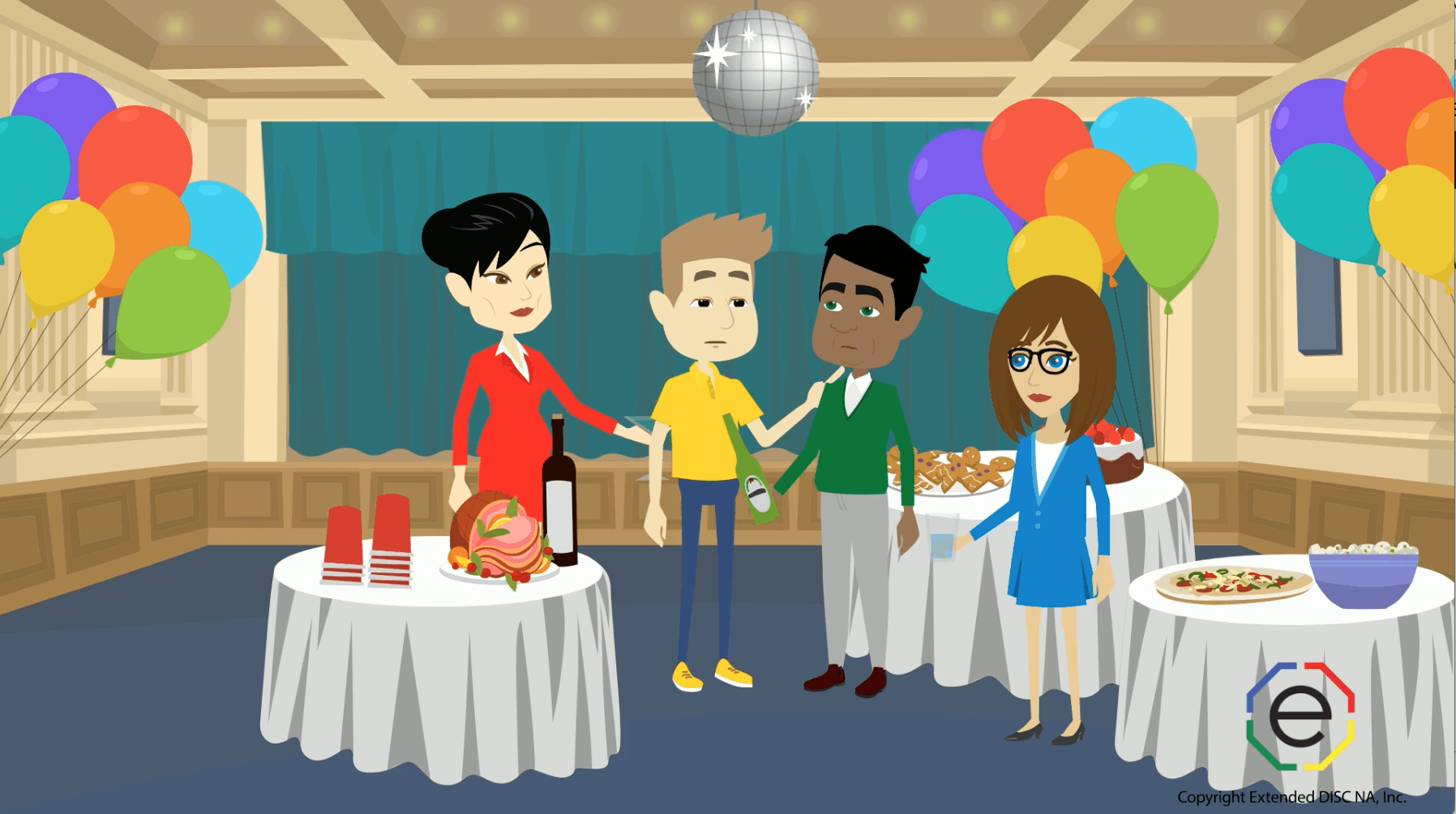What are some simple, yet effective tips to build better leadership DISC training content?
People ask, “what’s the best style for a leader?” The simple answer is there is no best DISC style. Successful leaders come from all styles. They bring their own unique strengths and challenges to their roles.
Effective DISC sessions help current and potential leaders develop themselves further, regardless of how successful they already are. It helps participants recognize the diversity in their roles, situations and team members. The end goal of any DISC leadership training should be to provide practical and easy to apply tools for participants to be better leaders.
Before you start
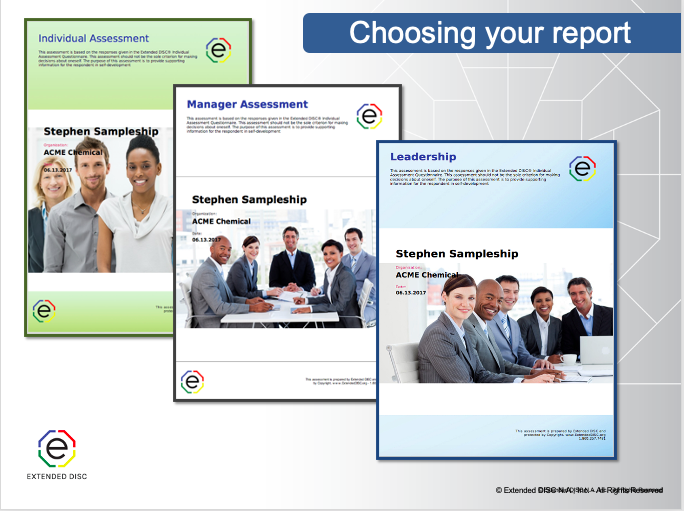 “I’m successful, why change?” People may not say it out loud, but many may feel their current success is because of how they’ve always done things. Leaders have already achieved a certain level of success or are on track because of their current position. However, I’m sure everyone can agree, all leaders can and should continue to develop.
“I’m successful, why change?” People may not say it out loud, but many may feel their current success is because of how they’ve always done things. Leaders have already achieved a certain level of success or are on track because of their current position. However, I’m sure everyone can agree, all leaders can and should continue to develop.
It’s important to remember, DISC is not about changing who you are. Rather, the most successful leaders stand out because they have confident self-awareness and an ability to adjust their styles.
First and foremost, determine your specific goals for the training. How are you going to use DISC to help your participants become more effective leaders? A good place to start is to consider why participants are attending your session; what are their expectations?
The selection of the Extended DISC® Assessment can help you build a better training. The Extended DISC® Leadership Assessment is the most obvious report to use because it speaks directly to your participants. It is designed to help leaders understand their own DISC styles, how to read the styles of their team members, and ultimately how to adjust their style to achieve winning results.
Laying the foundation for a great session
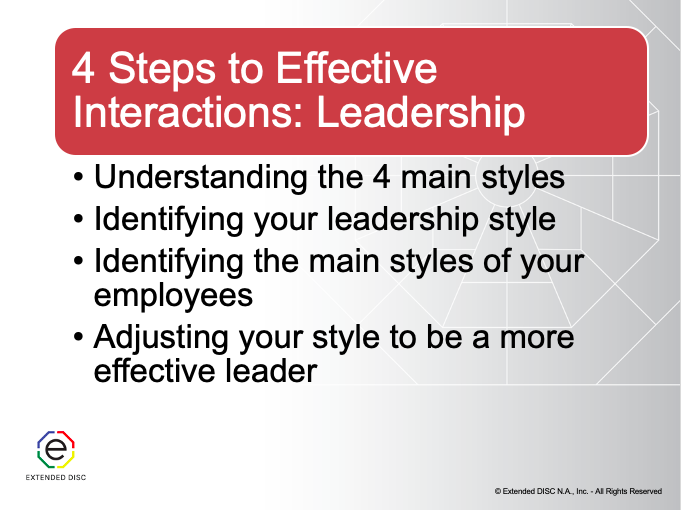 The 4 step approach to effective interactions is your template to building your leadership DISC training. The process is a simple and practical concept for participants to understand. More importantly, it includes application steps; allowing participants to put learning into practice. Furthermore, the Extended DISC® Leadership Assessment and support materials are built on this highly effective training outline. The four steps include:
The 4 step approach to effective interactions is your template to building your leadership DISC training. The process is a simple and practical concept for participants to understand. More importantly, it includes application steps; allowing participants to put learning into practice. Furthermore, the Extended DISC® Leadership Assessment and support materials are built on this highly effective training outline. The four steps include:
- Understanding the DISC styles
- Identify my DISC leadership style
- Identifying my employees’ styles
- Adjusting my style to lead more effectively
Once your participants understand DISC styles and their own leadership style, they are able to identify the diverse styles of their employees. Ultimately, they will have the information and tools to make more effective decisions on how to adjust their styles successfully.
You are providing your participants with a clear and consistent message by using the 4 Step approach. Your leaders will better understand how they are in control of their interactions and how to use their learnings to apply it to real world practice.
Step 1: Understanding the main leadership styles
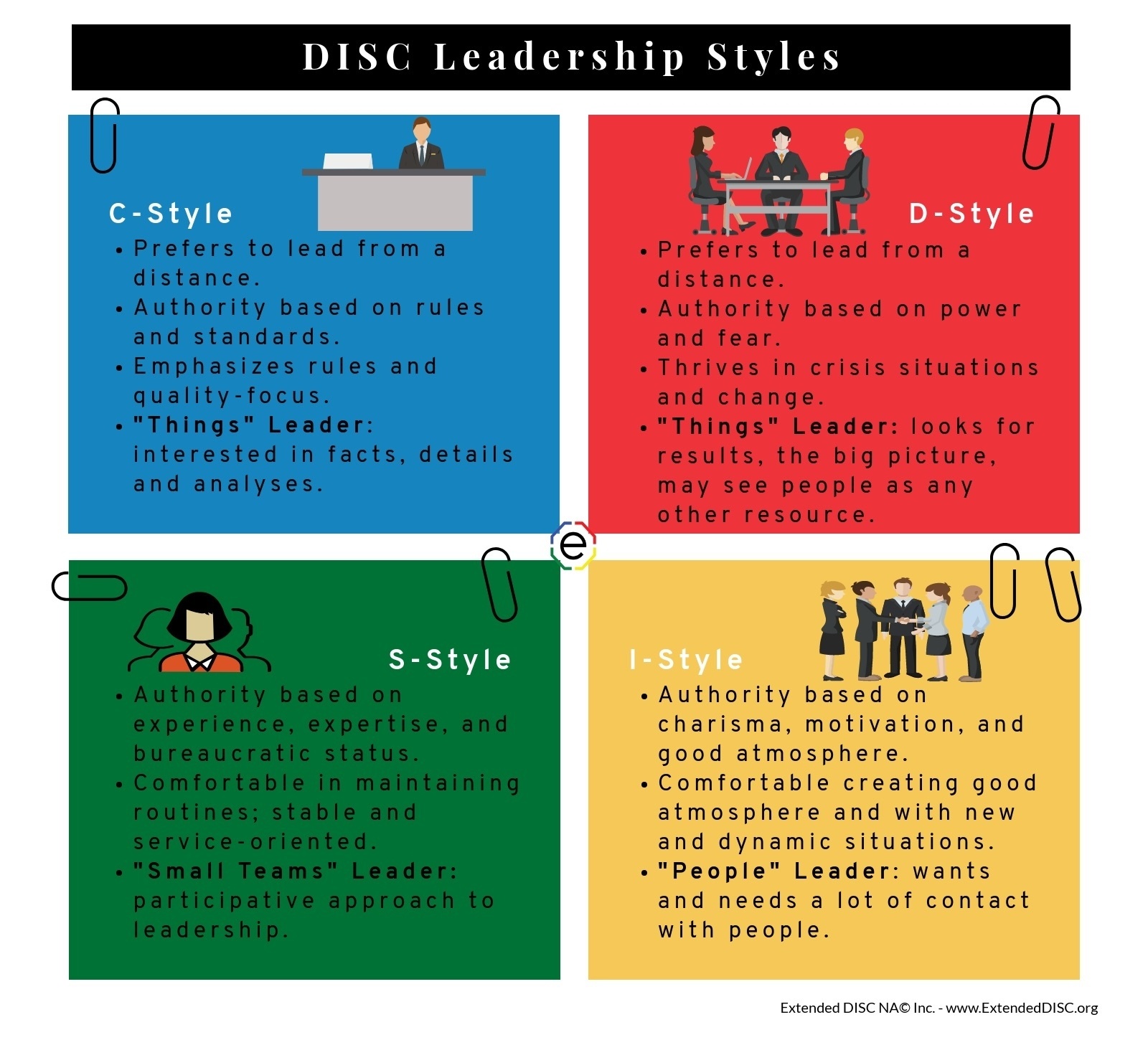 D-styles leaders emphasize a more authoritarian style of leadership; they direct and expect you to follow. They are focused on short-term, targeted results and may view employees as another resource. They tend to focus on speed and quick execution.
D-styles leaders emphasize a more authoritarian style of leadership; they direct and expect you to follow. They are focused on short-term, targeted results and may view employees as another resource. They tend to focus on speed and quick execution.
I-style leaders tend to be more informal and social around their teams. They prefer to focus on creativity, positivity, and enthusiasm; more than accuracy, tasks, or following rules. I-style leaders achieve results through and with people.
S-style leaders tend to be supportive and participative leaders; guiding, teaching, and developing team members. They prefer to focus on building lasting relationships and trust. S-style leaders promote gradual progress, while strongly focusing on shared long-term goals.
C-style leaders focus more on data, quality and rules; with little tolerance for mistakes. They prefer to keep a distance from their teams. C-style leaders prefer written communication to have time to review data and maintain a level of formality.
Remind your leaders, there is no best style for a leader; you are simply different. Your style brings its own strengths and development areas. The most effective leaders own their style, but also know when to adjust effectively.
Step 2: Your leadership style
 The Leadership Assessment clearly shows a person’s “true leadership style;” how they prefer to lead and communicate. Now, they have the necessary information on how to more effectively interact with their employees. It provides new and seasoned leaders with clear and useful information to develop confident self-awareness and presence.
The Leadership Assessment clearly shows a person’s “true leadership style;” how they prefer to lead and communicate. Now, they have the necessary information on how to more effectively interact with their employees. It provides new and seasoned leaders with clear and useful information to develop confident self-awareness and presence.
Our role as facilitator is to help participants understand and use their results. What are their strengths and development areas? How can they be more effective managing change? How can they better manage the dynamics of their team to be more productive and reach their goals? It also helps them understand how they can better develop and help employees achieve their goals.
You can highlight specific sections, such as motivating and developing your employees. Remember, it may be more effective in a group setting to focus on how to interpret their own results; giving them time to reflect and process it. You may also want to highlight the tips section, “Improving Your Success as a Manager.” It is based on their DISC style and is designed to further improve their abilities as leaders.
Ultimately, the goal of Step 2 is self awareness of how they comfortably lead and how their leadership style comes across to others.
Step 3: Identifying your employees’ styles

Once leaders have identified their own styles, the next step is to identify the styles of their employees. It’s about recognizing each employee’s unique differences and it enables them to make more effective behavioral modifications. This is a skill that takes some practice, but it is easy to learn and use.
Leaders learn to observe what their employees prefer to talk or write about, their tone of voice, and body language. They use the information to assess whether the employee is more task-oriented or people-oriented. Also, is the employee a more reserved or active style?
Once they have identified a main style, they now have more options for managing them. They have a better understanding of their motivations, strengths, development areas, and dynamics. Employees will likely respond more positively and leaders will achieve more favorable outcomes in their interactions. Remind your leaders, while the process is easy to learn and implement it still takes consistency and practice.
Step 4: Adjusting your leadership style
 Successful leaders are confidently self-aware; they know who they are. They use their strengths, but do not overuse them. At the same time, they are aware of the areas they need to improve upon and do not deny or ignore them.
Successful leaders are confidently self-aware; they know who they are. They use their strengths, but do not overuse them. At the same time, they are aware of the areas they need to improve upon and do not deny or ignore them.
Highly effective leaders practice modifying their behaviors to suit each interaction and setting. They are always mindful and present. They know how to lead, motivate and influence their different styles of employees. The top leaders identify the styles of others and modify their own style successfully.
Exercise and resource tips
 Now that you have the template to build your session, let’s share some activities to reinforce learning.
Now that you have the template to build your session, let’s share some activities to reinforce learning.
One of the simplest and most effective activity is asking the leader to identify their own teams on a chartpad and put it somewhere visible in their office. It is a great visual reinforcement tool. It’s a consistent reminder that their employees prefer to interact differently. It sends a powerful message to team members that their leaders value DISC and improving interactions, so they should as well.
Next, let’s focus on the report itself. A highly useful tip is to present the DISC report as a workbook. Have participants take a look at their own reports and immediately begin to take notes by highlighting statements. What statements resonate for them? What statements are they questioning? Which statements totally describe them? Answer the questions and worksheets in the report.
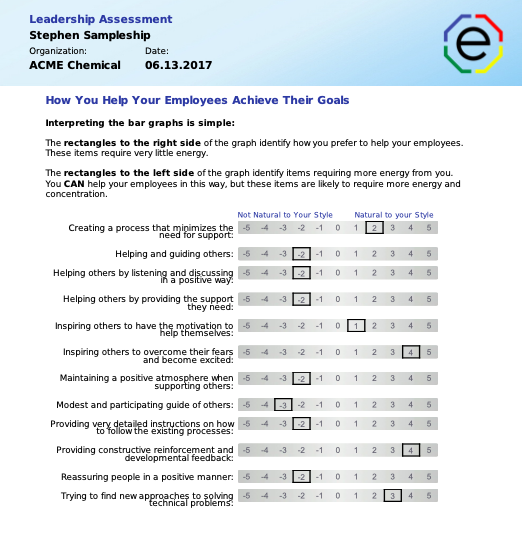 One way to engage participants with their results is to highlight the behavioral competency sections (bar graphs). Ask participants to identify the specifics behaviors which would have the greatest impact on their own performance, if they were to focus on them right now. Next, have them locate where their natural style (box on bar graph) falls for these targeted behaviors. Do they need to be more aware of or further develop the behavior?
One way to engage participants with their results is to highlight the behavioral competency sections (bar graphs). Ask participants to identify the specifics behaviors which would have the greatest impact on their own performance, if they were to focus on them right now. Next, have them locate where their natural style (box on bar graph) falls for these targeted behaviors. Do they need to be more aware of or further develop the behavior?
Final tips for sharing training goals
The main criteria for top leaders is the success of their teams; therefore, they need to interact effectively with their employees. Leaders who are able to relate well and build cohesive, productive teams are likely to have a winning way to lead.
The most successful leaders come from all different DISC profiles. DISC does not limit our success in any role. It does not measure our skills, attitude, experience, or knowledge. It focuses on behaviors because we can make positive adjustments to that aspect of who we are.
Participants can focus on their DISC style to better understand their unique strengths and what may be holding the back from reaching their full potential. It also helps them understand the diverse styles of their employees so they can make effective adjustments in their interactions.
Now, they have a starting point to greater success!

